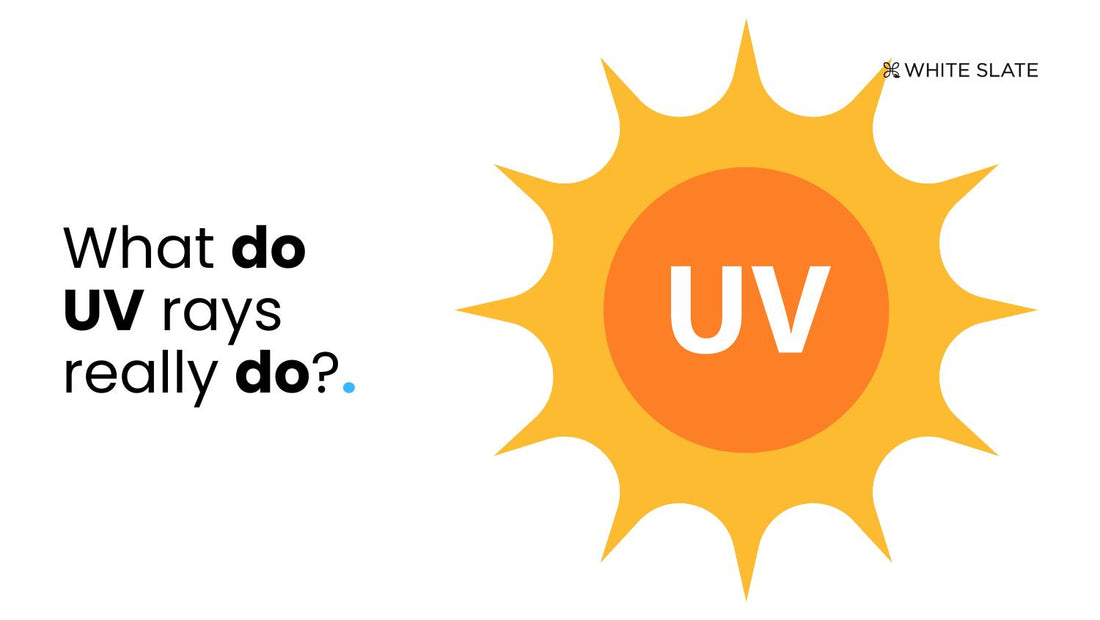Introduction
You’ve heard the warnings about sun damage a million times and yet every time you go outside a knot forms in your stomach. Will this day’s walk leave your skin feeling tight, irritated or prematurely aged? That nagging fear isn’t just vanity – it’s a real fear of long term damage. Knowing what UV rays do can turn fear into empowerment, giving you the knowledge to protect and nourish your skin rather than hiding indoors.
The Science Behind Solar Radiation
Sunlight is made up of several types of electromagnetic radiation. Among these, ultraviolet (UV) rays – specifically UVA and UVB – have enough energy to penetrate the atmosphere and interact with our skin. UVA rays, which make up about 95% of the UV radiation that reaches us, penetrate deep into the dermis. They accelerate photoageing, breaking down collagen and elastin fibres that keep us firm and elastic. UVB rays, although only making up about 5% of surface UV, are more energetic and damage the surface layers of the epidermis, causing sunburn and DNA mutations that can lead to skin cancer.
How UV Exposure Affects Your Skin
At a cellular level, UV photons excite molecules within skin cells, creating free radicals – unstable atoms that damage cell membranes, proteins and DNA. Repeated exposure to these reactive oxygen species undermines the skin’s natural repair mechanisms, manifesting externally as wrinkles, sagging and uneven pigmentation. In the short term, too much UVB exposure causes inflammation and redness (sunburn), while UVA causes long lasting discolouration and skin sensitivity. Left unchecked, cumulative damage increases your risk of actinic keratosis, melanoma and other carcinomas.
Protective Measures: Beyond Seeking Shade
While seeking shade and wearing protective clothing are the first line of defence, sunscreen is the frontline. A broad spectrum formula protects against UVA and UVB, reduces free radical formation and preserves your skin’s structure. If you have dry or sensitive skin, look for a sunscreen for dry skin that balances moisturisation with protection. Ingredients like glycerin, ceramides and plant oils help to reinforce the barrier, preventing the tightness and flakiness that some sunscreens can cause.
If you’ve ever wondered how to choose a sunscreen for dry skin, look for products with humectants and lipid replenishing agents. And if a sunscreen is the best sunscreen by dermatologist recommendations, it’s been tested for safety and efficacy so it’s suitable for even the most reactive skin types.
Key Ingredients to Look For
- Niacinamide Sunscreen: Sunscreen with Niacinamide soothes inflammation, strengthens the barrier and reduces TEWL (transepidermal water loss) perfect for dry or mature skin.
- Antioxidants: Vitamins C and E neutralise free radicals.
- Mineral Filters: Zinc oxide and titanium dioxide sit on the skin’s surface, deflecting UV rays without chemical absorption – great for sensitive skin.
- Hydrating Additives: Panthenol (vitamin B5), hyaluronic acid and squalane attract and lock in moisture, preventing dryness after sun protection.
Integrating Sun Care into Your Routine
Start with a gentle, non-foaming cleanser to remove impurities without stripping oils. After moisturising, apply a thick layer of sunscreen – about a teaspoon for your face and a shot-glass for your body – 30 minutes before sun exposure. Reapply every 2 hours or immediately after swimming or sweating. If you like a dewy finish, opt for a dry skin sunscreen that absorbs quickly but leaves a subtle glow. On days when you’re indoors but near windows, don’t skip protection; UVA rays pass through glass and affect your skin all day.
Frequently Asked Questions
1. Can I just use sunscreen?
No. Sunscreen is important but most effective when used with protective clothing, wide-brimmed hats and sunglasses. Seek shade especially between 11 am and 3 pm when UV is at its peak.
2. Is it safe to use a chemical sunscreen every day?
Broad-spectrum chemical filters are generally safe for daily use. But if you have sensitive skin or prefer a physical barrier, look for mineral-based options with zinc oxide or titanium dioxide.
3. How do I know if my sunscreen is still good?
Check the expiration date—most lose potency after 2-3 years. Also, note any changes in texture or smell; an oil-separated or rancid smell means it’s time to replace the bottle.
4. Does higher SPF mean better protection?
SPF 30 blocks around 97% of UVB rays, SPF 50 blocks about 98%. Above that it’s marginal. Focus on reapplying regularly rather than just chasing the highest number.
5. Can kids use adult sunscreen?
Kids’ skin is more delicate. It’s best to choose formulations specifically designed or recommended by paediatric dermatologists, often labelled as best sunscreen by dermatologist testing to ensure gentleness.
Disclaimer
This article is for informational purposes only and is not a substitute for medical advice. Individual skin types and conditions vary; consult a dermatologist before making major changes to your sun-care routine especially if you have a history of skin sensitivity or disease.

